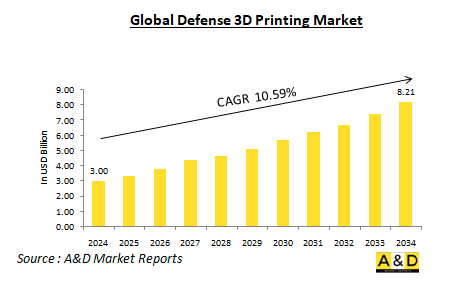
|
시장보고서
상품코드
1528162
세계의 방위용 3D 프린팅 시장(2024-2034년)Global Defense 3D Printing Market 2024-2034 |
||||||
세계 방위용 3D 프린팅 시장은 2024년 30억 달러로 추정되며, 예측 기간 중(2024-2034년) 10.59%의 연평균 성장률(CAGR)로 확대되었으며, 2034년까지 82억 1,000 만미 달러로 성장할 것으로 예상됩니다.

세계 방위용 3D 프린팅 시장 개요
적층 조형(AM)으로도 알려진 3D 프린팅은 방위 산업에 혁명을 일으키고 있습니다. 이 기술은 재료를 연속적으로 적층하여 3차원 물체를 만드는 것입니다. 재료를 제거하여 원하는 모양을 형성하는 기존의 제거 성형과는 달리, 3D 프린팅은 레이어별로 물체를 만듭니다. 방어에 미치는 영향은 큽니다. 신속한 프로토타이핑부터 최종 사용 부품 제조에 이르기까지 3D 프린팅은 방어 시스템의 설계, 제조 및 배포 방법을 바꾸고 있습니다.
세계 방위용 3D 프린팅 시장의 기술 영향
3D 프린팅이 방어 분야에 미치는 영향은 다면적입니다. 중요한 장점 중 하나는 신속한 프로토타이핑으로 3D 프린팅을 통해 설계부터 제조까지의 사이클을 가속화하여 프로토타입을 신속하게 반복하고 개선할 수 있습니다. 이 기능은 새로운 무기 시스템, 차량 및 장비의 신속한 개발로 이어져 변화하는 방어 요구에 신속하게 대응할 수 있습니다. 또 다른 이점은 공급망 최적화입니다. 부품의 현지 생산을 가능하게 함으로써 3D 프린팅은 복잡하고 취약한 공급망에 대한 의존성을 줄여줍니다. 이 기능은 기존 공급 라인이 중단될 수 있는 원격지와 적대적인 환경에서 특히 유용합니다. 3D 프린팅은 무게와 강도를 최적화하는 복잡한 모양을 만들 수 있어 경량화를 촉진합니다. 이것은 경량화가 성능과 효율성을 향상시키는 항공우주 및 지상 차량에 매우 중요합니다. 이 기술은 더욱 커스터마이징성을 높여 특정 요구와 조건에 맞게 고도로 커스터마이징된 부품과 부품을 생산할 수 있습니다. 이러한 유연성은 방어 용도에 보다 정밀한 솔루션을 제공합니다. 마지막으로 3D 프린팅은 주문형 예비 부품을 생산하여 물류 및 유지 보수에 이점을 제공하여 물류 문제와 다운 타임을 줄입니다. 이 기능은 방어 시스템의 유지보수 및 수리를 신속하게 수행할 수 있어 다양한 상황에서의 운영 태세를 유지합니다.
세계 방위용 3D 프린팅 시장의 주요 촉진요인
방위 산업에서 3D 프린팅의 보급을 촉진하는 몇 가지 요인이 있습니다. 주요 요인 중 하나는 운영 효율성입니다. 부품 및 프로토타입을 신속하게 제조할 수 있으므로 효율성이 크게 향상되고 비용이 절감되고 방어 기술의 개발과 배포가 간소화됩니다. 3D 프린팅 재료와 공정의 지속적인 개선으로 응용 범위가 확대되고 이 기술이 점점 범용적이고 효과적이기 때문에 기술 발전도 중요한 역할을 합니다. 공급망의 회복력도 중요한 추진력입니다. 세계적인 공급망에 대한 의존도를 줄임으로써 3D 프린팅은 방어 활동의 탄력성을 높여 까다로운 조건에서도 중요한 부품을 현지에서 생산할 수 있습니다. 지리적 이점은 3D 프린팅 채택에 더욱 기여합니다. 특히, 군사기지가 분산되어 있는 국가에서는 부품의 현지 생산에 의해 물류의 과제를 경감할 수 있습니다. 마지막으로, 3D 프린팅은 방어 산업에서 혁신과 실험 문화를 성장시킵니다. 이 기술은 새롭게 개선된 방어 기술의 개발을 촉진하고, 진보를 촉진하고, 빠르게 진화하는 분야에서 경쟁력을 유지합니다.
세계 방위용 3D 프린팅 시장의 지역별 동향
방위용 3D 프린팅의 지역 동향은 기술적 성숙도, 경제 상황, 지정학적 우선순위에 따라 달라집니다. 3D 프린팅의 선구자인 미국에서는 방위용 기술에 많은 투자가 이루어지고 있습니다. 여기에 초점은 고성능 구성 요소를 생산하기위한 고급 재료 및 프로세스의 개발이며 방어 기술의 발전에서 미국의 주도적 역할을 반영합니다. 유럽에서는 각국이 방어를 위한 3D 프린팅의 가능성을 적극적으로 모색하고 있으며, 협력과 표준화에 중점을 두고 있습니다. 유럽 국가들은 공통 표준을 개발하고 지식을 공유하기 위해 협력하고 있습니다. 이것은 다양한 방어 시스템에 3D 프린팅을 통합하고 전반적인 능력을 강화하는 데 도움이 됩니다. 아시아에서는 중국과 한국 등의 국가들이 3D 프린팅 능력을 빠르게 향상시키고 있습니다. 국내 산업정책과 방어예산 확대에 힘입어 이들 국가들은 방위부문을 강화하고 다양한 군용도를 지원하기 위해 3D 프린팅 기술에 많은 투자를 하고 있습니다. 기술 혁신으로 알려진 이스라엘은 군사 목적으로 3D 프린팅을 효과적으로 활용합니다. 이 국가는 무인 항공기(UAV) 및 기타 고급 시스템을 제조하는 데이 기술을 활용하고 있으며 방어 업무에 최첨단 기술을 통합하는 선두 주자입니다.
방위용 3D 프린팅의 주요 프로그램
호주 육군은 국방 분야에서 금속 3D 프린팅의 잠재적인 기회를 장려하고 있습니다. 호주 육군과 SPEE3D는 2021년에도 협력을 계속하고 12개월 동안 SPEE3D 기술을 테스트할 예정입니다. 호주 육군의 1차 전투 지원 대대는 현지 기업인 SPEE3D에 다시 협력의 기회를 주었습니다. 이번 제휴는 쉽게 사용할 수 있는 독자적인 금속 수리 부품의 재고를 크게 강화할 수 있는 신기술 개발에 집중합니다.
해사 및 방위 산업을 위해 캐나다는 최초의 3D 인쇄 금속 연구시설을 건설했습니다. 뉴 브런즈윅 대학은 CFM(Custom Fabricators and Machinists) 및 뉴 브런즈윅 주 및 노바스코시아 주 커뮤니티 기관과 공동으로 Marine Additive Manufacturing Centre of Excellence를 설립했습니다. 이 센터는 금속 3D 프린팅을 사용하여 해양 산업용 인증 맞춤 부품을 제조하는 국내 최초의 센터로 연구, 상업화, 노동력 개발 및 훈련을 결합합니다. 센터장에서 UNB 기계공학 부교수의 모프센 모하마디 박사가 센터의 연구개발 활동을 담당합니다.
스페인 조선사 Navantia는 적층 조형을 이용하여 스페인 해군 F-110 프리깃(군함) 5척을 건조함으로써 국방부와 합의했습니다. 이 회사에 따르면 이러한 함선은 3D 프린터로 제조된 부품이나 함선을 위협으로부터 보호하는 사이버 보안 시스템 등 Industry 4.0 기술을 도입한 함대 최초의 함선입니다. 5척 프리깃함은 스페인 해군의 ASTILLERO 4.0 프레임워크의 일환으로 최첨단 통합 제어 및 시뮬레이션 시스템(디지털 트윈)을 사용하여 건조됩니다. 이 프레임워크는 보다 효과적인 운송 네트워크를 구축하기 위해 디지털화를 활용하고 선박을 건조하는 방법을 바꾸려는 Navantia의 노력의 일부입니다.
목차
방위용 3D 인쇄 시장 : 보고서 정의
방위용 3D 프린팅 시장 내역
- 용도별
- 지역별
- 재료별
방위용 3D 프린팅 시장 분석(향후 10년간)
방위용 3D 프린팅 시장 시장 기술
세계 방위용 3D 프린팅 시장 예측
방위용 3D 프린팅 시장 : 지역별 동향 및 예측
- 북미
- 촉진·억제요인, 과제
- PEST 분석
- 시장 예측과 시나리오 분석
- 주요 기업
- 공급자 계층의 상황
- 기업 벤치마킹
- 유럽
- 중동
- 아시아태평양
- 남미
방위용 3D 프린팅 시장 : 국가별 분석
- 미국
- 방어 계획
- 최신 동향
- 특허
- 이 시장의 현재 기술 성숙 수준
- 시장 예측과 시나리오 분석
- 캐나다
- 이탈리아
- 프랑스
- 독일
- 네덜란드
- 벨기에
- 스페인
- 스웨덴
- 그리스
- 호주
- 남아프리카
- 인도
- 중국
- 러시아
- 한국
- 일본
- 말레이시아
- 싱가포르
- 브라질
방위용 3D 인쇄 시장 : 시장 기회 매트릭스
방위용 3D 프린팅 시장 : 조사에 관한 전문가의 견해
결론
Aviation and Defense Market Reports 정보
JHS 24.08.14The Global Defense 3D Printing Market is estimated at USD 3.00 billion in 2024, projected to grow to USD 8.21 billion by 2034 at a Compound Annual Growth Rate (CAGR) of 10.59% over the forecast period 2024-2034.

Introduction to Defense 3D Printing Market:
3D printing, also known as additive manufacturing, is revolutionizing the defense industry. This technology involves creating three-dimensional objects by successively layering materials. In contrast to traditional subtractive manufacturing, which removes material to form a desired shape, 3D printing builds up objects layer by layer. The implications for defense are profound. From rapid prototyping to the production of end-use parts, 3D printing is transforming how defense systems are designed, manufactured, and deployed.
Technology Impact in Defense 3D Printing Market:
The impact of 3D printing on the defense sector is multifaceted. One significant advantage is rapid prototyping, where 3D printing accelerates the design-to-production cycle, enabling rapid iteration and refinement of prototypes. This capability leads to faster development of new weapons systems, vehicles, and equipment, allowing for quicker adaptation to changing defense needs. Another benefit is supply chain optimization. By enabling local production of parts, 3D printing reduces reliance on complex and vulnerable supply chains. This capability is particularly beneficial in remote or hostile environments, where traditional supply lines may be disrupted. 3D printing also facilitates light weighting by allowing for the creation of complex geometries that optimize weight and strength. This is crucial for aerospace and ground vehicles, where weight reduction can lead to improved performance and efficiency. The technology further enhances customization, enabling the production of highly customized parts and components tailored to specific needs and conditions. This flexibility allows for more precise solutions in defense applications. Finally, 3D printing offers advantages in logistics and maintenance by producing spare parts on demand, reducing logistical challenges and downtime. This capability ensures that defense systems can be maintained and repaired quickly, maintaining operational readiness in various situations.
Key Drivers in Defense 3D Printing Market:
Several factors are driving the adoption of 3D printing in the defense industry. One major factor is operational efficiency; the ability to rapidly produce parts and prototypes significantly improves efficiency and reduces costs, streamlining the development and deployment of defense technologies. Technological advancements also play a crucial role, as continuous improvements in 3D printing materials and processes expand the range of applications, making the technology increasingly versatile and effective. Supply chain resilience is another key driver. By reducing reliance on global supply chains, 3D printing enhances the resilience of defense operations, ensuring that critical components can be produced locally even in challenging conditions. Geographic advantages further contribute to the adoption of 3D printing, particularly for countries with dispersed military bases, where local production of parts can mitigate logistical challenges. Finally, 3D printing fosters a culture of innovation and experimentation within the defense industry. This technology encourages the development of new and improved defense technologies, driving progress and maintaining a competitive edge in a rapidly evolving field.
Regional Trends in Defense 3D Printing Market:
Regional trends in defense 3D printing vary based on technological maturity, economic conditions, and geopolitical priorities. In the United States, which is a pioneer in 3D printing, significant investments have been made in the technology for defense applications. The focus here is on developing advanced materials and processes to produce high-performance components, reflecting the country's leading role in advancing defense technologies. In Europe, countries are actively exploring the potential of 3D printing for defense, with a strong emphasis on collaboration and standardization. European nations are working together to develop common standards and share knowledge, which helps in integrating 3D printing into various defense systems and enhancing overall capabilities. In Asia, countries like China and South Korea are rapidly advancing their 3D printing capabilities. Driven by domestic industrial policies and expanding defense budgets, these nations are investing heavily in 3D printing technology to bolster their defense sectors and support a range of military applications. Israel, known for its innovation, has effectively leveraged 3D printing for military purposes. The country utilizes the technology for the production of unmanned aerial vehicles (UAVs) and other advanced systems, showcasing its role as a leader in integrating cutting-edge technologies into its defense operations.
Key Defense 3D Printing Program:
The Australian Army continues to encourage potential opportunities for metal 3D printing within the Defense sector. The Australian Army and SPEE3D will continue their collaboration in 2021, with plans to test SPEE3D technology for an additional 12 months. Once more, the 1st Combat Service Support Battalion of the Australian Army has given local firm SPEE3D the chance to work with them. This time, the alliance will concentrate on creating new techniques that might vastly enhance the stock of readily accessible unique metal repair parts.
For the maritime and defence industries, Canada constructed its first 3D printing metal research facility. The University of New Brunswick, in collaboration with Custom Fabricators and Machinists (CFM) and community institutions in New Brunswick and Nova Scotia, established the Marine Additive Manufacturing Centre of Excellence. The centre, which is the first in the nation to use metal 3D printing to make certified custom parts for the marine industry, will combine research, commercialization, and workforce development and training. The center's director and associate professor of mechanical engineering at UNB, Dr. Mohsen Mohammadi, will be in charge of the center's research and development activities.
The Spanish shipbuilder Navantia has an agreement with the Ministry of Defense to build five F-110 frigates (warships) for the Spanish Navy using additive manufacturing. These ships will be the first in the fleet, according to the business, to incorporate Industry 4.0 technologies with 3D printed components and cybersecurity systems that protect ships from threats. The five frigates will be built using cutting-edge integrated control and simulation systems, or a digital twin, as part of the Spanish navy's ASTILLERO 4.0 framework. This framework is a component of Navantia's effort to change the way ships are built so that it takes advantage of digitalization to create more effective transportation networks.
Table of Contents
Defense 3D Printing Market Report Definition
Defense 3D Printing Market Segmentation
By Application
By Region
By Material
Defense 3D Printing Market Analysis for next 10 Years
The 10-year Defense 3D Printing Market analysis would give a detailed overview of Defense 3D Printing Market growth, changing dynamics, technology adoption overviews and the overall market attractiveness is covered in this chapter.
Market Technologies of Defense 3D Printing Market
This segment covers the top 10 technologies that is expected to impact this market and the possible implications these technologies would have on the overall market.
Global Defense 3D Printing Market Forecast
The 10-year Defense 3D Printing Market forecast of this market is covered in detailed across the segments which are mentioned above.
Regional Defense 3D Printing Market Trends & Forecast
The regional Defense 3D Printing Market trends, drivers, restraints and Challenges of this market, the Political, Economic, Social and Technology aspects are covered in this segment. The market forecast and scenario analysis across regions are also covered in detailed in this segment. The last part of the regional analysis includes profiling of the key companies, supplier landscape and company benchmarking. The current market size is estimated based on the normal scenario.
North America
Drivers, Restraints and Challenges
PEST
Market Forecast & Scenario Analysis
Key Companies
Supplier Tier Landscape
Company Benchmarking
Europe
Middle East
APAC
South America
Country Analysis of Defense 3D Printing Market
This chapter deals with the key defense programs in this market, it also covers the latest news and patents which have been filed in this market. Country level 10 year market forecast and scenario analysis are also covered in this chapter.
US
Defense Programs
Latest News
Patents
Current levels of technology maturation in this market
Market Forecast & Scenario Analysis
Canada
Italy
France
Germany
Netherlands
Belgium
Spain
Sweden
Greece
Australia
South Africa
India
China
Russia
South Korea
Japan
Malaysia
Singapore
Brazil
Opportunity Matrix for Defense 3D Printing Market
The opportunity matrix helps the readers understand the high opportunity segments in this market.
Expert Opinions on Defense 3D printing Market Report Report
Hear from our experts their opinion of the possible analysis for this market.
Conclusions
About Aviation and Defense Market Reports



















